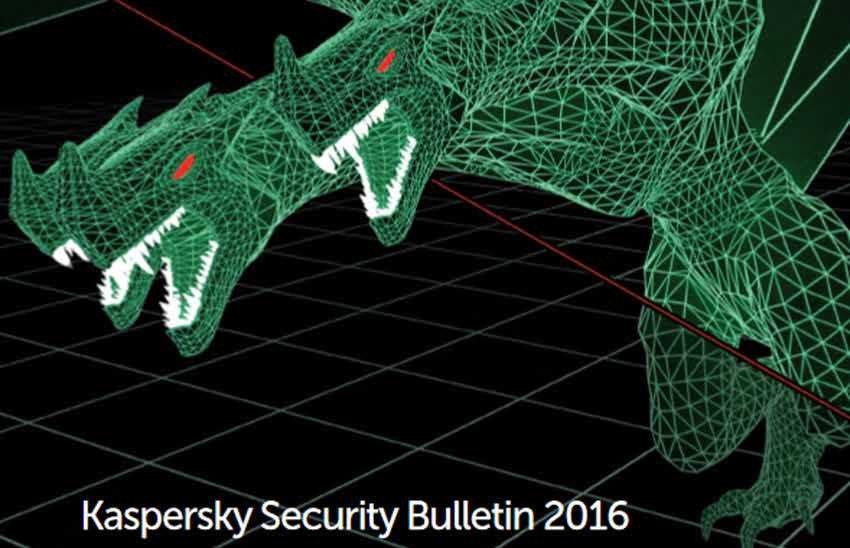Kaspersky: 2016, the biggest digital threats worldwide, concerned finances, information, and the desire to disrupt and violate data. These included the illegal trade in tens of thousands of login elements from broken serverss, ATM interception, ransomware, mobile banking malware, as well as cyber espionage attacks, but also hacking and leakage sensitive personal data. 
These negative trends, their effects and the data they contain are covered by the annual one Report Kaspersky Security Bulletin Review And the Statistical References her.
Το 2016 η έρευνα της Kaspersky Lab αποκαλύπτει επίσης το βαθμό που οι επιχειρήσεις αγωνίζονται να εντοπίσουν γρήγορα και αποτελεσματικά κάποιο περιστατικό ασφαλείας: το 28,7% των επιχειρήσεων αναφέρει ότι τους πήρε αρκετές ημέρες να εντοπίσουν ένα τέτοιο γεγονός, ενώ το 19% παραδέχτηκε ότι χρειάστηκε εβδομάδες, αν όχι και περισσότερο χρόνο. Για μία μικρή αλλά σημαντική μειοψηφία της τάξεως του 7,1%, ο εντοπισμός διήρκησε μήνες. Ανάμεσα σε εκείνους που «πάλεψαν» περισσότερο, τελικά ο εντοπισμός του προβλήματος οφείλεται συχνά στους εσωτερικούς ή εξωτερικούς ελέγχους ασφαλείας, ή από ειδοποιήσεις τρίτων, όπως από πελάτη ή καταναλωτή. Περισσότερες πληροφορίες για το πόσο η delay του εντοπισμού απειλών επηρεάζει το κόστος ανάκαμψης της businesss, you can find at SUMMARY OF MAIN POINTS of the report.
Other things we learned about 2016:
- The shadow economy is bigger and more sophisticated than ever: just look at it xDedic - the shadow market for over 70.000 connection data from infringing servers that allowed anyone to buy access to a broken server, such as someone on a government network in an EU country for just $ 6
- The largest financial robbery did not include stock trading, as expected: instead, SWIFT transactions were used to steal 100 million dollars.
- Critical infrastructures are alarmingly vulnerable in many places, as revealed at the end of 2015 and its principles 2016 through the digital assault BlackEnergy in the Ukrainian energy sector, which involved disabling the electricity grid, deleting data and launching a DDoS attack. 2016, Kaspersky Lab's specialists have explored the potential for industrial control threats and have discovered thousands of Internet-wide providers across the globe, with 91,1% have vulnerabilities which one can manage remotely.
- A targeted attack may not follow any pattern: as it was shown by ProjectSauron APT, an advanced, modular digital espionage team that adapted its tools according to each goal, reducing their value as Indices of Compromise (IOCs) for any other victim.
- The electronic release of huge volumes of data can directly affect what people think and believe: as evidenced by ShadowBrokers and personal and political data leaks.
- A webcam or a DVD player could be part of a world-wide digital army of Internet-of-things: as the year ends, it is clear that the attacks related to Mirai botnet is just the beginning.
“The number and scope of digital attacks and their victims that we encountered in 2016 put the issue of better detection at the top of the business agenda. Detection is now a complex one procedure που απαιτεί τεχνογνωσία στον τομέα της ασφάλειας, βαθιά γνώση του τοπίου των απειλών, αλλά και την ανάπτυξη δεξιοτήτων για να εφαρμοστεί η τεχνογνωσία αυτή σε κάθε οργανισμό. Η ανάλυσή μας επάνω στις ψηφιακές απειλές όλα αυτά τα χρόνια έχει φέρει στην επιφάνεια τόσο συγκεκριμένα μοτίβο όσο και μοναδικές προσεγγίσεις. Αυτή η συσσωρευμένη κατανόηση στηρίζει ενεργά τα εργαλεία άμυνάς μας, καθώς πιστεύουμε ότι οι τεχνολογίες προστασίας θα πρέπει να τροφοδοτούνται από την τεχνογνωσία στον τομέα της ασφάλειας. Επίσης, έγκειται στο επίκεντρο του αυξανόμενου αριθμού εταιρικών μας σχέσεων και συνεργασιών. Χρησιμοποιούμε το παρελθόν για να προετοιμαστούμε για το μέλλον, έτσι ώστε να μπορούμε να συνεχίσουμε να προστατεύσουμε τους πελάτες μας από προηγουμένως άγνωστες απειλές, πριν προλάβουν να προκαλέσουν οποιαδήποτε ζημιά» said David Emm, Principal Security Researcher Kaspersky Lab.
In a special video on Youtube you can see the overview of information security protection.
The remarkable statistics for the year 2016 include:
- 36% of online τραπεζικών επιθέσεων στοχεύουν τώρα συσκευές Android, έναντι μόλις του 8% το 2015
- 262 million URLs were identified as malicious by Kaspersky Lab products, and there were 758 million malicious cyber-attacks worldwide - with one in three (29%) coming from the US and 17% from the Netherlands
- There were eight new "families" of malware for Point-of-Sale and ATM - an increase of 20% compared to 2015
- Attackers have used the Google Play Store to distribute malware for Android devices, with "infected" applications having "gone down" hundreds of thousands of times





